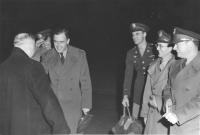So a versatile and trained force moved through Detroit, St Paul, Seattle, Vancouver, Victoria, Salem, San Francisco and down to Los Angeles for Christmas. Meanwhile, word had come that General George Marshall had decided to release all MRA full-time men from the armed forces immediately so that they could resume their life's work. On 26 December, the first six arrived together at Los Angeles airport. Buchman, in tears, greeted them in silence. Then he turned towards the cars saying, 'Well, you're home. And now let's get into the fight.'
According to Reginald Hale, Buchman told them sadly that he could never return to Europe. 'He was nearing seventy, his health was frail and his right hand paralysed. But it was not that which made him hesitate,' he writes. 'All too clearly he saw the immense task of reawakening faith in a hate-fragmented Europe ... Then the Servicemen had come home bringing stories of bridgeheads which MRA-trained soldiers had built in country after liberated country. Within a week he was planning to move to Europe.'6

Another element which influenced him was the publication of the salient points of the Gestapo report of 1942, Die Oxford-Gruppenbewegung,in the British press. A letter in The Times in December from a distinguished all-party group,* gave details of the report and commented, 'The whole report throws an interesting light on the Nazi mind, as well as finally dispelling the widespread misrepresentations which have been circulated about this Christian movement.' The letter concluded, 'It is vital that we should understand the spiritual foundations of democracy as clearly as did our enemies, and that we should sustain with all our strength what they feared and hoped to destroy.'7 DeWitt Mackenzie, the leading foreign affairs columnist of the Associated Press, had been in London that December, had obtained a sight of the original report and wrote a column in a similar vein which was carried widely in North America.8
(* Lord Ammon, Deputy Leader of the House of Commons; Harold E. Clay, Chairman of the London Labour Party; Lord Courthope, President of the National Union of Conservative Associations; the Bishop of Lichfield; Sir Lynden Macassey, Chairman of Reuters; Sir Cyril Norwood, President of St John's College, Oxford: Sir David Ross, Provost Oriel College, Oxford.)
To many reasonable people this disposed of a misrepresentation which had followed Buchman and his people on both sides of the Atlantic. But the lie did not die easily. It became known that copies of the Gestapo document had been in the hands of British Intelligence for at least a year before The Times letter appeared. An intelligence report, dated 7 January 1945, came to light in which the writer had stated that it would be better if the Gestapo report did not fall into the hands of Moral Re-Armament, as it would destroy the allegations made against them. However, a copy of the report was found in the offices of the Haut-Rhin hydro-electric works, which had been used by Gestapo officers between 1940 and 1944, and was sent by an engineer in the company, Pierre Koechlin, to Paris and finally to MRA's London headquarters. Hence the letter in The Times.
334
Photo: When General Marshall ordered the early release from the armed forces of some of Buchman's key workers, Buchman was at the airport to meet them.
©Arthur Strong/MRA Productions